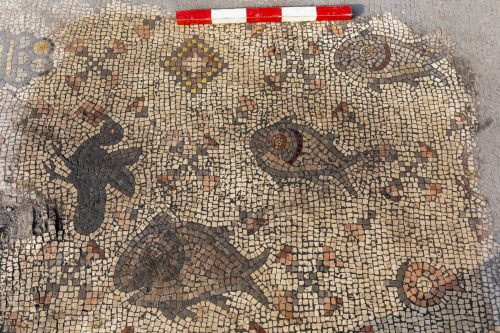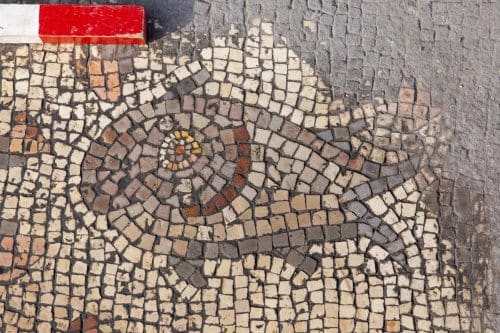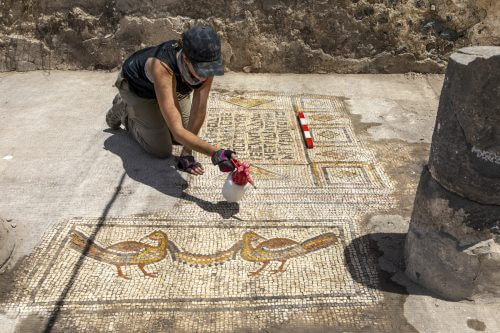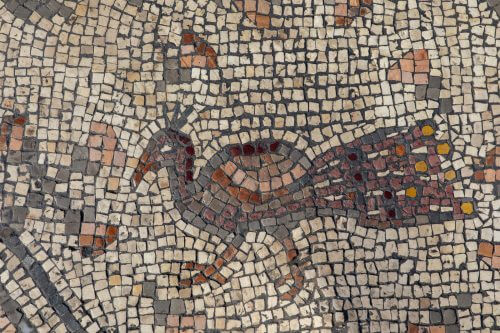Susita, overlooking the Sea of Galilee from Mount Nisha, about 2 km to the east, is within the "Susita National Park" of the Nature and Parks Authority. It was the central city in the region of East Kinneret and South Golan during the Roman period. The old city has been being uncovered for twenty years by a delegation from the Institute of Archeology at the University of Haifa. This exposure allows the Nature and Parks Authority to develop Susita National Park in these months for public visits

A well-preserved colorful mosaic full of decorations, which includes dedicatory inscriptions and descriptions of baskets of bread and fish, was uncovered during excavations by researchers of the University of Haifa in the "burnt church" in Susita. According to the researchers, the descriptions in the mosaic together with the location of the church, overlooking the Sea of Galilee, immediately bring up the connection to the "miracle of the bread and fish" performed by Jesus, according to the New Testament, in the area. "Certainly there can be different explanations for the descriptions of the bread and fish in the mosaic, but it is also impossible to ignore the similarity to what is described in the New Testament: for example, the fact that in the New Testament there is a description of five loaves of bread in a basket or the two fish described in the apse," said Dr. Michael Isenberg, head of the excavation delegation To Sosita on behalf of the Institute of Archeology at the University of Haifa.
Susita, overlooking the Sea of Galilee from Mount Nisha, about 2 km to the east, is within the "Susita National Park" of the Nature and Parks Authority. It was the central city in the region of East Kinneret and South Golan during the Roman period. The old city has been being uncovered for twenty years by a delegation from the Institute of Archeology at the University of Haifa. This exposure allows the Nature and Parks Authority to develop Susita National Park in these months for public visits.
A few weeks ago, researchers uncovered the "burnt church", which was built in the fifth century AD and was apparently burned down during the Sasanian occupation at the beginning of the seventh century. This is a church that was partially uncovered about a decade ago, and now Dr. Isenberg and his partner in the management of the excavation, Arlata Koblewska, have returned to uncovering it. Precisely thanks to the fire, the church was well preserved, since the roof system burned and collapsed on the floor of the church, thus covering it with a layer of ash that protected it from the ravages of time. Now, when the researchers returned to uncover it, they discovered a magnificent mosaic, which was preserved in an excellent way. The excavation of the church was entrusted to the hands of Jessica Rantz from the USA who revealed the interior area of the church, which is 15 x 10 m. During the excavation of the main entrance area, she uncovered within the remains of the charred doors a pair of doorknobs cast in bronze in the form of roaring lions. During the conservation process, led by Jana Vitklov from the Antiquities Authority, most of the mosaic carpet was cleaned and preserved and most of its decorations and two inscriptions were revealed. The first one tells about the two fathers of the church, Theodore and Peter, building a shrine to the martyr, while the second one, contained within a medallion in the center of the mosaic, reveals the saint's name - Theodore. An initial reading of the inscriptions was done by Dr. Gregor Staub from the University of Cologne in Germany, epigrapher of the ancient Greek expedition.

According to Dr. Isenberg, the people who ordered the mosaics wanted to create a highly emphasized and dense coloration on a rather small budget, which includes models and descriptions of birds, fish and fruits that do not leave empty spaces. In some of the baskets, the researchers discovered five or more loaves of bread of different colors (some claim that these are not loaves, but unidentified fruits), which together with the fish were associated with the miracle of the bread and fish described four times in the New Testament. According to the New Testament, Jesus performed the miracle in an isolated area, probably in the northeast of the Sea of Galilee, where he fed a crowd of about 5,000 men with the help of five loaves of bread and two fish, not counting the women and children. Then, as is said, he performed the miracle of walking on water and reached the northwestern side of the Sea of Galilee. In this place, today's Kibbutz Ginosar/Tobaha, the Church of the Bread and Fishes was established already in the fifth century AD, and according to Christian tradition - this is the place where the miracle took place.
Dr. Isenberg continues to be cautious about the interpretation of the new mosaic, however, he points out that there are several points that deserve attention, "Today, we tend to see the 'Loaves and Fishes' church in Tabaha in northwest Kinneret as the location of the miracle, and indeed the ancient tradition links the event to the site, but a reading Zahira in the New Testament points out that this actually could have happened just north of Susita in the city's control area. According to the scriptures, after the miracle, Jesus crossed the water on its northwestern side, to the Tabacha/Ginoser area - so the miracle should have occurred where he began the crossing and not where he finished it. In addition, in the mosaic in the Church of the Bread and Fishes there is a description of two fish and a basket of bread containing only four loaves - while in all the places in the New Testament that tell about the miracle, five loaves are indicated, as found in the mosaic in Susita. In addition, 12 baskets are depicted in the mosaic in the burnt church, and also in the New Testament the apostles describe that at the end of the miracle, 12 baskets with bread and fish remained. Depicting loaves of bread in baskets in the art of mosaics is very rare, so if indeed these are loaves of bread depicted here, similar to the mosaic in the Church of the Bread and Fishes, one cannot help but wonder about the connection between them and the two experiences of Jesus near the shores of the Kinneret," noted Dr. Isenberg.

However, he is also aware that there are also differences between what is described in the mosaic of the burned church and the description in the New Testament: for example, some of the baskets in the mosaic are full of fruit and not just bread and in other places there are three fish, next to each other, and not just two. "The church is right at the western end of Mount Sosia and is the westernmost in the city and overlooks - then as today - the Sea of Galilee and the area of Jesus' work and a significant part of his miracles. There is no doubt that the local community was intimately familiar with the two miracles of the loaves and fishes and perhaps even knew its approximate location better than we did. An explanation that the artist or those who commissioned the work wanted to create an association with a miracle that occurred not far away is certainly logical. We will finish digging and clean the remaining twenty percent of the mosaic and will carefully examine this hypothesis. The fish themselves have a number of additional symbolic meanings for the Christian world and great caution is required in the interpretation", he concluded.


One response
Gentiles! Whore!